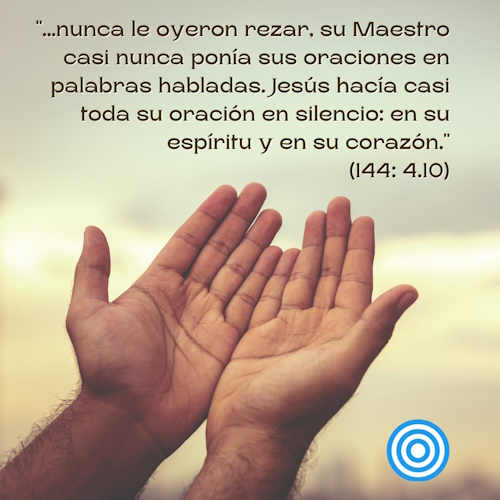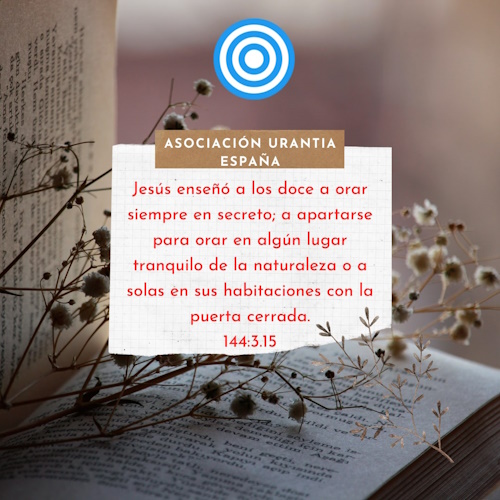© 2022 María José Sánchez Santamaría
© 2022 Urantia Association of Spain

“An old story tells that in a small town such a storm broke out that the river overflowed its banks and completely flooded everything. The inhabitants escaped as they could, but the priest, who had always been a man of great faith, remained at the entrance of the parish, praying to God to get him out of there.”
“At that moment, a man was passing by driving a pickup truck who yelled at him:”
“– Father, come on, the water continues to rise!”
“- Do not worry son. replied the priest, God will save me.”
“The water level continued to rise and the priest, waist-deep in water, continued to pray. Then a rowboat passed by with several men, who called out to him to get on.”
“The priest responded firmly:”
“– You go, do not worry about me anymore, God will save me.”
“The men moved away while the storm did not stop and the water continued to rise; so much so that the priest had to climb to the roof of the parish. When the water was about to cover everything, a helicopter approached the priest from where they signaled for him to take the rescue rope, but he refused:”
“– I am a man of faith! he yelled at the helicopter, God save me!”
“However, the water continued to fall and the priest ended up drowning and reached the gates of heaven. When he found himself face to face with God, he could not help but reproach him for letting him die like that.”
“My Lord,” said the priest sadly, “why did you abandon me?”
“– But what abandonment are you talking about? God replied, I sent you a truck, I sent you a boat, and I sent you a helicopter!”

This story was told to me in joke format when I was little and over the years I realized that it had more teachings, since we all have God very close at hand and we don’t know how to see him. We need to wake up to the authentic reality, because this will give a radically different and wonderful meaning to our existence.
In the spiritual tradition of Kabbalah they tell us about the importance of waking up from the dream in which we are immersed in our lives, but from which we can get out when we become aware that THERE IS NO SATISFACTION in things or material achievements, when we feel unhappiness even having it everything, when nothing seems to give us fullness. That’s when that awakening occurs. At that moment is when you become aware that life is not about having but about BEING.
Kabbalists call this elevated state of our soul “the point of the heart.” The great teacher Raúl Durán describes how a process can be produced by which we ascend in the pyramid of desires: we would start looking for the satisfaction of our material body, then ascending in the pyramid with the search for wealth, progressing towards more fame. or power, then would come the desire for knowledge until finally reaching the desire for spiritual growth, to satisfy ourselves only with contact with our Creator, our Father. Thus we awaken spiritually at that “point of the heart” that transforms us in our perception of reality.
The readers of The Urantia Book have in our beloved Master someone who lived at that marvelous point of contact with Divinity, since the world was for Him a mirror of the Love in which we are living. And now, in this time that we live in, we are in great need of images that make it clear that God is not far away or outside, but inside and here, always at hand.
Jesus used multiple images more than two thousand years ago to bring us closer to this divine reality, when he compared the Kingdom of God with a coin, with a net, with a seed, etc. But in reality it is not that he was looking for something to compare the kingdom of God with, rather it would be necessary to say that he saw that kingdom in the pearl, in the coin, in the wedding, in the boats that went sailing… He saw in all those everyday examples to God and then, enthusiastic, he told it with joy, with such force that he infected many with his vision. I saw a tree and in the tree (not behind it) I saw life, I saw a mother and her son, and that mother and her son were Life itself. All creatures were for him so alive that they revealed the Creator. I was radically awake, I saw reality as it is.
We all need stories like this, transparent, that help us see things as they really are and act from the heart of life. To act, as we surely did in our childhood, dazzled by the continuous wonder, wonder and trust in our parents.
How did Jesus achieve that continuous connection with the Source? He himself helps us, because his teachings on prayer were also simple and clear, direct and groundbreaking with respect to many beliefs in his environment on how to relate to God. It is a Master showing a better way:
Jesus was particularly averse to praying in public. Up to this time the twelve had heard him pray only a few times. They observed him spending entire nights at prayer or worship, and they were very curious to know the manner or form of his petitions
Jesus taught the twelve always to pray in secret; to go off by themselves amidst the quiet surroundings of nature or to go in their rooms and shut the doors when they engaged in prayer. (UB 144:3.13-14)
The priest Pablo D’Ors tells us that one of the most characteristic features of Jesus was his great pedagogical will, to be a Teacher. He understood very soon that, in addition to announcing, he had to teach. His way of being a Master, his teachings, sought to be simple and brief, almost everyone could understand what he was saying, although at different levels of depth. He did not use to argue or develop theories, quite the contrary. She always started from an image, she was an artist: the lilies of the field, the lost coin, the yeast, the cloak, the birds… all her words were images. That is why his preaching was not forgotten and has passed to posterity.
Notice this slightly humorous example of a annoying and annoying neighbor, which Jesus uses to make clear to us the importance of persistence and focus. All the things that surrounded him could reveal Truth, all the images served him:
If any one of you has a neighbor, and you go to him at midnight and say: ‘Friend, lend me three loaves, for a friend of mine on a journey has come to see me, and I have nothing to set before him’; and if your neighbor answers, ‘Trouble me not, for the door is now shut and the children and I are in bed; therefore I cannot rise and give you bread,’ you will persist, explaining that your friend hungers, and that you have no food to offer him. I say to you, though your neighbor will not rise and give you bread because he is your friend, yet because of your importunity he will get up and give you as many loaves as you need. If, then, persistence will win favors even from mortal man, how much more will your persistence in the spirit win the bread of life for you from the willing hands of the Father in heaven. Again I say to you: Ask and it shall be given you; seek and you shall find; knock and it shall be opened to you. For every one who asks receives; he who seeks finds; and to him who knocks the door of salvation will be opened. (UB 144:2.3)
The first conclusion of all this innovative approach of Jesus is that prayer does not need temples or churches, since the temple is ourselves: our body is the sanctuary where what we call prayer occurs. The adventure of the soul is verified in our body.
From there we arrive at another revolutionary conclusion: if the temple is not necessary to pray, the priests and the assembly are not necessary either. Closing the door is essential, the door is closed to the outside so that it can be opened to the inside. Not surprisingly, since the relationship between the beloved and the beloved demands intimacy.
Another key also refers to an important warning that Jesus gave:
Jesus warned his followers against thinking that their prayers would be rendered more efficacious by ornate repetitions, eloquent phraseology, fasting, penance, or sacrifices. (UB 146:2.15)
Praying does not consist in talking a lot, asking eloquently for things, because words, when they are not born from the depths, tend to interfere with the flow of life until they block it; and because when we ask it is always because we have some personal interest. Prayer really doesn’t go that way. This is how instead of being a means, words can often become an obstacle.
Silence, on the other hand, devoid of ideas and emotions, is the framework in which we listen and are listened to, in which we look and are looked at; and that is precisely what prayer consists of.
Silence can never be an obstacle, it is too discreet, humble and naked to hinder anything. No one can be proud of being silent better than another. For this reason, silence is the area in which the spirit can reveal itself more clearly.
One of the reasons why Peter, James, and John, who so often accompanied Jesus on his long night vigils, never heard Jesus pray, was because their Master so rarely uttered his prayers as spoken words. Practically all of Jesus’ praying was done in the spirit and in the heart—silently. (UB 144:4.10)
So, let’s do as our dear Master: let’s enter our room, enter our body, close the door to the senses, separating external stimuli and calming our mind, to listen and look inward, towards Him. Because in the silent room from our stilled body and from our silenced mind is that Source and Center that will satisfy us forever. There will finally be our satisfied heart. We will feel that we are finally awake.